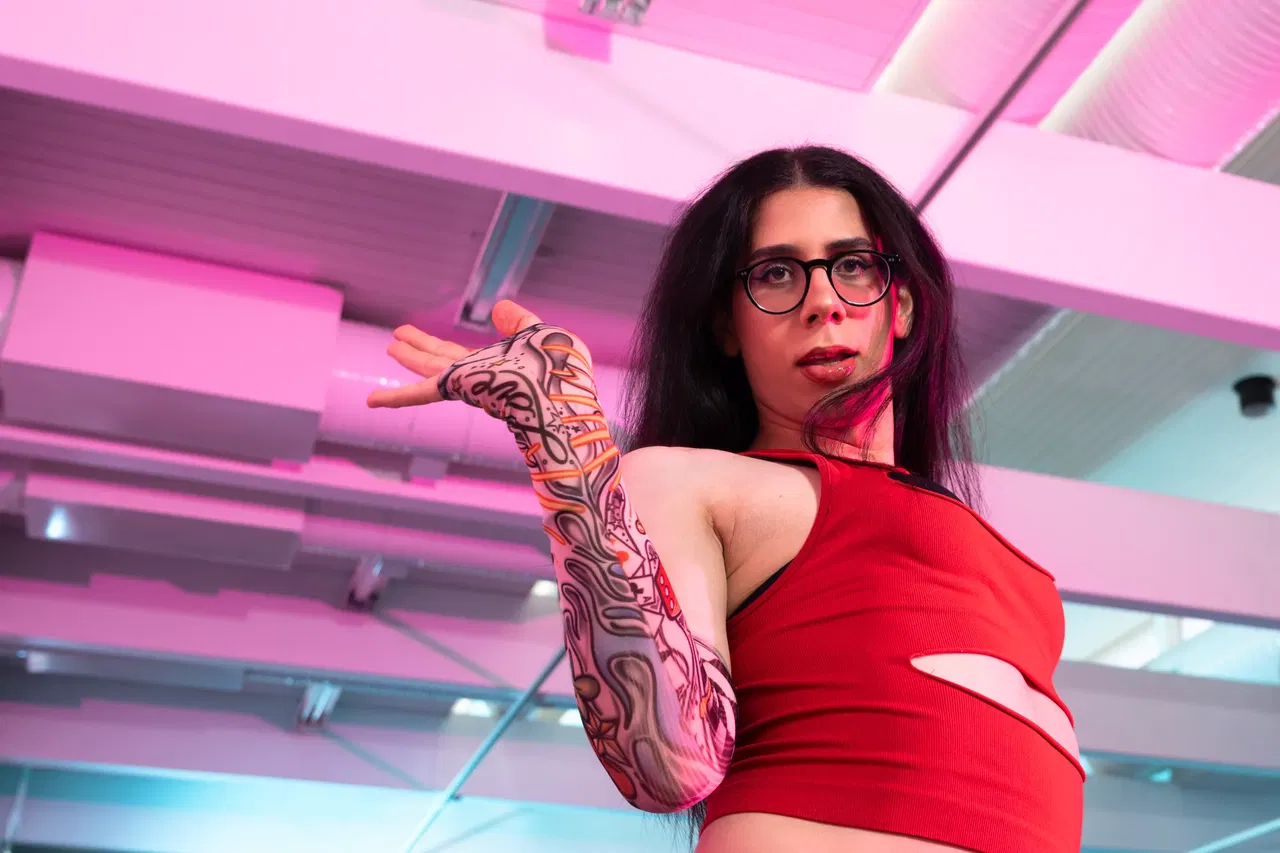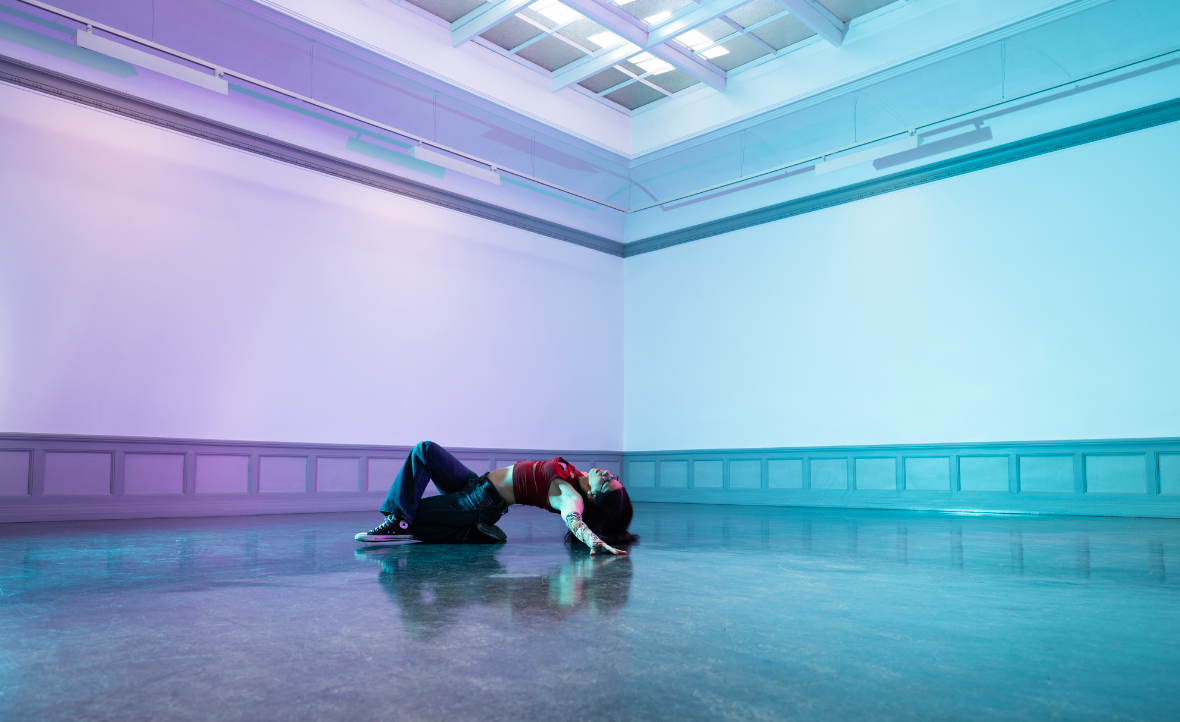
Kunsthall Stavanger is proud to make its website available to activist and performer, Zutana Hadaddeen. Haddadeen grew up in the Stavanger region and has in recent years become known for her tireless work as an activist working for trans rights. This comes after breaking with a conservative background where she struggled to find acceptance.
As part of the digital project Even When We Can't We Must, photographs of Hadaddeen are given free reign on Kunsthall Stavanger's website. The photographs that normally reside on the website are overridden by images of Hadaddeen striking voguing poses from ballroom culture in the kunsthall’s galleries. This project seeks to shed light on how public spaces historically and currently restrict and disallow trans bodies. Haddadeen is at the centre of the work, and by using the freedom of movement in ballroom, she dominates the room. Here, Hadaddeen is voguing, her body language simultaneously
Kunsthall Stavanger is proud to make its website available to activist and performer, Zutana Hadaddeen. Haddadeen grew up in the Stavanger region and has in recent years become known for her tireless work as an activist working for trans rights. This comes after breaking with a conservative background where she struggled to find acceptance.
As part of the digital project Even When We Can't We Must, photographs of Hadaddeen are given free reign on Kunsthall Stavanger's website. The photographs that normally reside on the website are overridden by images of Hadaddeen striking voguing poses from ballroom culture in the kunsthall’s galleries. This project seeks to shed light on how public spaces historically and currently restrict and disallow trans bodies. Haddadeen is at the centre of the work, and by using the freedom of movement in ballroom, she dominates the room. Here, Hadaddeen is voguing, her body language simultaneously challenging us and inviting us to participate in what seems to be an act of liberation.
Yet, the idea of freedom in this context is inexact. Artist-scholar, DJ, and Assistant Professor of Modern Culture and Media at Brown University, madison moore, has written extensively on aesthetic, sonic and spatial strategy in the context of the queer experience, including the ballroom scene. In his text Contents Under Pressure: A (Queer) Techno Manifesto, he writes that freedom is not the correct word for the strategy utilised in queer nightlife. Rather, he writes, rave is “the temporary autonomous zone where we create spaces of release—not utopia, not freedom, not safety. Release.”
Encountering the photographs of Hadaddeen gives us the experience of observing a body that is indeed releasing; that is letting go, expressing and unfolding. In contrast to the traditional situations we are used to seeing in the gallery space – carefully curated art exhibitions consisting of contemporary expressions such as paintings, video, sculpture or installation, or the way we often act as onlookers; diligent, silent, observing – in Spaces of Release the sole focus becomes Hadaddeen’s body and the energetic release she is creating in this space. In her expression of ballroom, Hadaddeen focuses on ‘vogue femme’, a form of ballroom that academic, activist and performer Julian Kevon Glover describes as “heavily influenced by jazz, ballet, and modern dance, with an emphasis on fluidity, the expression of movements considered ‘feminine,’ and the five elements – spins/dips, catwalk, duckwalk, hands, and floor performance”. Hadaddeen’s body simultaneously conjoins and breaks with the space, creating dynamics formerly unknown to the gallery. She marches against us in a deep squat, stretches and twists on the floor, or simply relishes in her own bodily movement.
In the context of ballroom, it is impossible for performers to partake without acknowledging the scene’s rich and impactful history. For Hadaddeen, it is crucial to acknowledge how the art form has relied on and owes a lot to black and brown trans women who have shaped the movement. In their text, Glover describes how the styles of ballroom in different ways are about emphasising the “telling [of] one’s own story through movement”. This is evident in the photographs of Hadaddeen – she pays tribute to the form’s history while also unpacking and reframing her own personal narrative. Every movement we see is inspired by the history of ballroom, but takes on Hadaddeen’s own past and present; she is the one expressing and experiencing the movements in real time.
The ballroom scene is continuously evolving, but at its core, the form has always relied on spatial conversion and the way the performer is tasked with moulding the energy of a space. It is easy to relate the body and the energy of bodily expression to the theories Sara Ahmed lays out in her seminal book Queer phenomenology (2006). Ahmed writes about the notion of queer space, a space where objects don’t exist in the vertical (we can allow ourselves to think of this as the normative) in a space, but on a slant. In this paradigm, could ballroom offer a possibility to reorient ourselves in a space? As the body breaks societal norms for a space and ceases to exist on the vertical – namely in our expectation of how we are supposed to act in a gallery – Hadaddeen’s movements shift to inhabit a dynamic slant. If we allow for the gallery space to take on a discursive quality, we can imagine that the art exhibited by Hadaddeen is a step in changing the way we orient around what is considered normative. In Spaces of Release Hadaddeen forces us to acknowledge her body and expression, and by proxy open a potential for changing our own orientation of what we experience as the normative. The project opens up for us to refocus and shift our perception of other public spaces and who belongs there.
Curator: Kristina Ketola Bore
Developer: Bryant Wells
Photographs: Helle Navratil
Zutana Hadaddeen is an activist, performer and influencer. Known for her work to promote trans rights, Hadaddeen is also active on social media, first known for her humoristic tiktok videos. She often contributes to the public debate, among other things in the form of panel debates. At the age of 20, she has managed to win and be nominated for several awards for her work, among them Skamløsprisen from the organisation Sex og Samfunn, local newspaper Stavanger Aftenblad's BYAS award, the Rainbow Gala's Queer Role Model and a nomination for national newspaper Dagens Næringsliv Ledestjerne (Leading Star) in 2022. Hadaddeen has also featured in several TV and video productions, among them Norwegian broadcaster NRK’s programme Helene checks out trans women and a Pride campaign for Amnesty. Her most recent project includes participating as a dancer in a Travis Scott music video scheduled for release next year.
Haddadeen was born in Jordan to a Jordanian father and a Palestinian and Armenian mother. She has since grown up in the Stavanger region as part of a religious group, where she was not accepted for being queer. Today she lives in Copenhagen.
The year 2022 marks the 50th anniversary of the repeal of a law that prohibited sexual acts between men 50 years ago, effectively decriminalising being gay in Norway.
Kunsthall Stavanger honours Queer Culture Year with a digital project consisting of four commissioned works by Nat Pyper, Olivia Douglass, virgil b/g taylor and Zutana Hadaddeen. The works are presented as interactive projects on our digital platform, with the first launching in December 2022, and the others following in March, May and September 2023.
The title for the project, Even When We Can't We Must, is borrowed from a work by Nat Pyper bearing the same name.















